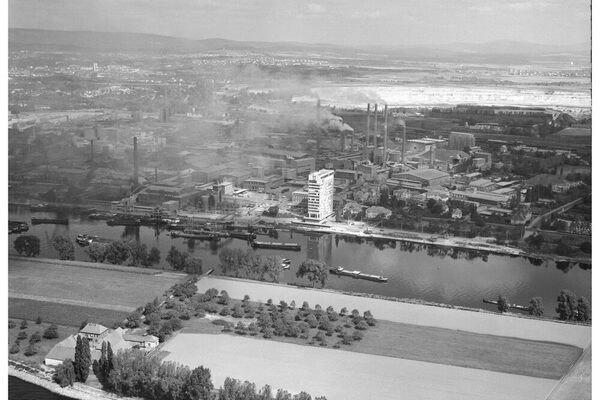Albert Chemical Works
Chemische Werke Albert was founded in Biebrich in 1858 by the pharmacist Heinrich Johann Albert as an "agricultural-chemical and glue factory". In 1859, his brother Eugen (1830-1879) joined the company as commercial manager. In 1861, the factory was relocated from the Duchy of Nassau to Amöneburg in the Grand Duchy of Hesse (Darmstadt). In 1863, the company set up a factory relief fund for sick and disabled workers. Ten years after the company was established, a grinding plant was built on the River Lahn to utilize the phosphorite available there. This meant that the fertilizer factory was no longer exclusively dependent on animal waste as a raw material. The company gained European and ultimately global significance with the development of double superphosphate in 1871. In 1877, Chemische Werke Albert acquired the first imperial patent, and by 1883 it employed over 600 workers.
Another important discovery was the fertilizing effect of finely ground so-called Thomas slag, a waste product of the iron industry. In 1884, the production of Thomas flour from phosphate slag began, followed by the production of potash nitrate in 1892. In 1895, the plant was transformed into the public limited company "Chemische Werke vorm. H. & E. Albert". In 1909, the annual turnover of Chemische Werke Albert reached one million tons.
Before the First World War, the company was in an excellent position with more than 24 factories of its own in Germany and abroad, but had to accept the loss of its foreign factories and patents at the end of the war and finally changed its production completely: pharmaceuticals were produced from 1922 onwards. In 1938, the company name was changed to "Chemische Werke Albert". The workforce at the plants in Amöneburg, Mannheim and Kaiserslautern numbered 1,500 employees. In 1940, Chemische Werke Albert merged with "Chemische Fabrik Dr. Kurt Albert" in Amöneburg, founded in 1910, which held the first patents in the field of phenolic resins (Albertole) and had been developing heat-curable plastics since 1930. Dr. Kurt Albert-Siedlung GmbH, founded in 1934 with the "Albert-Siedlung" on the Gräselberg, also belonged to this plant. In September 1944, the plant facilities in Amöneburg were largely destroyed in a bombing raid and 38 employees died. After the dismantling of the facilities in 1946, the plant was rebuilt, focusing on the production of crop protection products from 1949 (discontinued in 1961). In 1964, Farbwerke Hoechst AG took over the majority of shares. In 1972, Chemische Werke Albert was integrated into the Hoechst Group and converted into a management company, and in 1989 it was merged to form the Kalle-Albert plant.
Literature
150 years of history of Chemische Werke Albert: A chronology. Infraserv GmbH & Co. Wiesbaden KG (ed.), Wiesbaden 2008.
